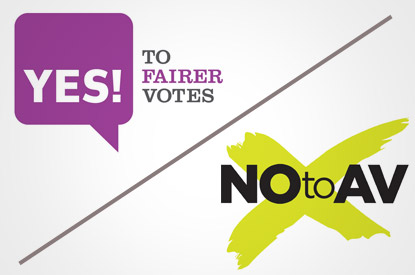
Photo: Flickr
First Past The Post (FPTP); this is the sole sentence a non-voter need utter to justify why, come May, much like in 2010, and 2005, and 2001, and every election day which went before, they did not exercise the most liberating and hard fought right U.K. citizens possess. And I don’t blame them in the slightest.

Photo: Channel 4
Sure, we can recycle the old rhetoric about how people died to give us the vote and that you can’t complain about the government if you don’t put that empty ‘X’ in the box, but regretfully, these tired lines from vote-obsessed citizens (much like myself) just don’t wash anymore. Our voting system is not democratic. It is not liberating. It does not encourage voter participation.
Frankly, it is a national embarrassment.
FPTP often confuses people. The system we share with 50 other countries to elect M.P.s to Westminster works by giving power to the party which receives the most votes. The devastating reason why this is undemocratic is that it regularly leads to the party with the largest minority forming the government. In 2005, Tony Blair was re-elected as Prime Minister with a mere 35% of the vote. What this means in reality is that although 65% of people did not want a Labour government, their vote counted for absolutely nothing, because they got one. They might as well have stayed at home on election day, and that fact is criminal.
In the election next year, I can vote for the first time in either the North East or the South East. However, my vote is redundant. FPTP encourages a two-party system because the dominant Conservative and Labour parties regularly get the largest minority vote, leaving every other party, regardless of how many votes they received, excluded from Parliament. This fact creates the problem of tactical voting. If voters feel that only two parties have a chance of winning, they might sacrifice voting for a fringe party which they like and vote for the major party they least dislike, simply to prevent their most disliked party from forming the government.
For example, if I were to vote for the Green party next May I would be wasting my vote, because under FPTP they are likely to have extremely few candidates elected. Tactically, I should vote Labour because I do not want to see a Conservative or UKIP government. But ultimately, if my preferred party are excluded by FPTP, why should I vote at all?
So, if FPTP does not create a parliament which is a microcosm of the public vote and excludes fringe parties and discourages voters from participating in elections if not all together then partly because of tactical voting, then why do we use it?

Photo: Policy Periscope
In 2011, the U.K. staged a referendum on the issue, giving the electorate the opportunity to change the voting system to the alternative vote. AV involves voters listing candidates in order of preference in single member constituencies. Votes are counted and if no single candidate receives over 50% of the vote, the least popular candidate is eliminated and voters second choices taken into account, with the process being repeated until a candidate receives over 50% of the votes. This was overwhelmingly rejected; the ‘no’ vote was 67%. If FPTP is so terrible, why did the electorate so recently decide to maintain it? The answer; the referendum was a flawed process.
Firstly, A report by the electoral commission found that a majority of voters lacked sufficient knowledge of both voting systems and methods. In fact, many voters though the referendum was actually to change the voting method; that is, how we vote, be it in person, by post etc. Other voters did not understand AV, primarily because they had no experience of using it. However, undoubtedly the most undemocratic element of the referendum was the inexplicable decision to offer AV as the alternative system. AV, by the way, which is only used in 3 other countries; Australia, Papua New Guinea and good old Fiji. Despite a proposal from Green M.P. Caroline Lucas to give the public of choice of 3 alternate voting systems, the government inexplicably offered us only AV. I say inexplicably because the Liberal half of the coalition were in favour of moving to a proportional system, something which AV is not. However, given that the Conservative party support FPTP, mainly because it usually returns themselves or the Labour party to power, the referendum’s constricted choice is not too surprising.
What this country desperately needs is a fully proportional system, primarily because they have to have multi-member constituencies and this fact very regularly results in parties getting the same share of parliamentary seats as they get share of the vote. The favoured example of many fringe parties and other European countries is the single transferable vote. The electorate rank candidates in order of preference, who are elected once they pass the threshold. Transferring votes eliminates waste votes previously used on sure winners or sure losers under FPTP. Also, the use of multi-member constituencies stops the problem under AV of candidates and parties who receive a considerable amount of votes not getting parliamentary representation because they can take the second or third seat from the district.

Cartoon: Lesslie.com
Change, unfortunately, seems very unlikely, especially when we consider the 2011 referendum. Also, a proportional system would allow representation for fringe parties, something many voters may not be so keen on when we consider the rise of the controversial Ukip.
However, voter turnout will remain disappointing because FPTP so often takes away any real incentive to bother voting for so many people by making their vote redundant.
Vote on May 7th! And give the carpenter a ladder while you’re at it.
Photo: Flickr
First Past The Post (FPTP); this is the sole sentence a non-voter need utter to justify why, come May, much like in 2010, and 2005, and 2001, and every election day which went before, they did not exercise the most liberating and hard fought right U.K. citizens possess. And I don’t blame them in the slightest.
Photo: Channel 4
Sure, we can recycle the old rhetoric about how people died to give us the vote and that you can’t complain about the government if you don’t put that empty ‘X’ in the box, but regretfully, these tired lines from vote-obsessed citizens (much like myself) just don’t wash anymore. Our voting system is not democratic. It is not liberating. It does not encourage voter participation.
Frankly, it is a national embarrassment.
FPTP often confuses people. The system we share with 50 other countries to elect M.P.s to Westminster works by giving power to the party which receives the most votes. The devastating reason why this is undemocratic is that it regularly leads to the party with the largest minority forming the government. In 2005, Tony Blair was re-elected as Prime Minister with a mere 35% of the vote. What this means in reality is that although 65% of people did not want a Labour government, their vote counted for absolutely nothing, because they got one. They might as well have stayed at home on election day, and that fact is criminal.
In the election next year, I can vote for the first time in either the North East or the South East. However, my vote is redundant. FPTP encourages a two-party system because the dominant Conservative and Labour parties regularly get the largest minority vote, leaving every other party, regardless of how many votes they received, excluded from Parliament. This fact creates the problem of tactical voting. If voters feel that only two parties have a chance of winning, they might sacrifice voting for a fringe party which they like and vote for the major party they least dislike, simply to prevent their most disliked party from forming the government.
For example, if I were to vote for the Green party next May I would be wasting my vote, because under FPTP they are likely to have extremely few candidates elected. Tactically, I should vote Labour because I do not want to see a Conservative or UKIP government. But ultimately, if my preferred party are excluded by FPTP, why should I vote at all?
So, if FPTP does not create a parliament which is a microcosm of the public vote and excludes fringe parties and discourages voters from participating in elections if not all together then partly because of tactical voting, then why do we use it?
Photo: Policy Periscope
In 2011, the U.K. staged a referendum on the issue, giving the electorate the opportunity to change the voting system to the alternative vote. AV involves voters listing candidates in order of preference in single member constituencies. Votes are counted and if no single candidate receives over 50% of the vote, the least popular candidate is eliminated and voters second choices taken into account, with the process being repeated until a candidate receives over 50% of the votes. This was overwhelmingly rejected; the ‘no’ vote was 67%. If FPTP is so terrible, why did the electorate so recently decide to maintain it? The answer; the referendum was a flawed process.
Firstly, A report by the electoral commission found that a majority of voters lacked sufficient knowledge of both voting systems and methods. In fact, many voters though the referendum was actually to change the voting method; that is, how we vote, be it in person, by post etc. Other voters did not understand AV, primarily because they had no experience of using it. However, undoubtedly the most undemocratic element of the referendum was the inexplicable decision to offer AV as the alternative system. AV, by the way, which is only used in 3 other countries; Australia, Papua New Guinea and good old Fiji. Despite a proposal from Green M.P. Caroline Lucas to give the public of choice of 3 alternate voting systems, the government inexplicably offered us only AV. I say inexplicably because the Liberal half of the coalition were in favour of moving to a proportional system, something which AV is not. However, given that the Conservative party support FPTP, mainly because it usually returns themselves or the Labour party to power, the referendum’s constricted choice is not too surprising.
What this country desperately needs is a fully proportional system, primarily because they have to have multi-member constituencies and this fact very regularly results in parties getting the same share of parliamentary seats as they get share of the vote. The favoured example of many fringe parties and other European countries is the single transferable vote. The electorate rank candidates in order of preference, who are elected once they pass the threshold. Transferring votes eliminates waste votes previously used on sure winners or sure losers under FPTP. Also, the use of multi-member constituencies stops the problem under AV of candidates and parties who receive a considerable amount of votes not getting parliamentary representation because they can take the second or third seat from the district.
Cartoon: Lesslie.com
Change, unfortunately, seems very unlikely, especially when we consider the 2011 referendum. Also, a proportional system would allow representation for fringe parties, something many voters may not be so keen on when we consider the rise of the controversial Ukip.
However, voter turnout will remain disappointing because FPTP so often takes away any real incentive to bother voting for so many people by making their vote redundant.